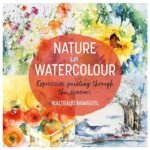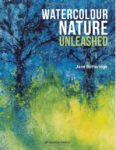This book was reduced to under a tenner on Amazon and I thought I deserved…

David Bellamy’s Arctic Light – Book Review
Here’s another book review, as promised. David Bellamy’s Arctic Light is a reassuringly robust feeling 176–page hardback.
And, for the first time in ages, I’m looking at a book that was exactly what I thought it would be. About 160 pages of it is an artistic Arctic travelogue, the remainder being some tips on what I’d call extreme plein air watercolour painting.
So, first up, the travelogue. This part of the book is divided up into six chapters, each based around one or two Arctic expeditions. Most of these expeditions are in Greenland but there’s also a trip to Iceland and a trip to the Svalbard Islands, East of Greenland and North of Norway. All the expeditions are described in lots of detail, all mishaps and problems included. And the scenery is well described and illustrated by some fantastic paintings. David’s poetic language brings the landscape to life, makes me want to visit it (well, maybe Iceland as I’m a bit put off by the polar bears otherwise) and, more importantly, makes me want to paint. Just like with any book like this you find yourself going backwards and forwards between the main body of text, the text attached to the paintings and the paintings themselves.
The chapter on extreme plein air painting didn’t teach me anything useful, to be honest as that’s not my sort of thing. But it still worked for me as an extension of the rest of the book, adding more details to David’s journey and the problems he faces just painting.
The benefit to my painting from this book just comes from inspiration. There’s the inspiration to paint that comes through in the poetic language but there’s also a lot to learn from just looking at David’s paintings. Just looking at how much granulation he has in his skies, the colours he puts in the ice, the colours he puts into non–icy bits that work well against the icy colours behind them. Some of these paintings have colours and effects that remind me a lot of the tundra supergranulators and give me ideas about how better to use them. Whenever I revisit this book, it’s probably going to be to look at the pictures and to learn from them. The book on learning from Turner’s paintings might even prove useful to me in studying and learning from David’s work.
Before we get to the scores on the doors, a random thought. I was reading a review of a book somewhere that described a book as the sort of book that an artist would never buy but that people buy artists as gifts. It was referring generally to books of the “Encyclopaedia of Techniques with Medium X” type, with lots of two page spreads giving shallow coverage of individual techniques that are either already common knowledge or that really need to be discussed at greater length. They tend to get marketed as the only book about medium X that you’ll ever need. I must admit I’ve been sucked in by one of these books. But my point is this. If you’re looking to buy a book for a watercolour artist and don’t know what they want, you can’t go wrong with a book like this one. David also has a book on Arabian Light that’s on my wishlist and there’s the Hazel Soan book on Africa, but David’s, with their solid hardback feel, kind of work better as gifts.
The final score? Well, this was a pleasure to read and will be a source of inspiration for years but I’m limiting scores for books that are all inspiration and no learnings to three palettes. This feels unfair on a book that I’ve nothing negative to say about but that’s how my ratings work. As a gift or as one more book in the collection of someone who thinks he has everything, this works well. I really hope people read the words in my reviews and don’t just look at the ratings. I’ve lots of positive things to say about three and even two palette rated books.
🎨🎨🎨
You can find this book and more reviews of it at Amazon UK here. As an Amazon Associate, I earn commission from qualifying purchases but this costs absolutely nothing extra to you.








Leave a Reply